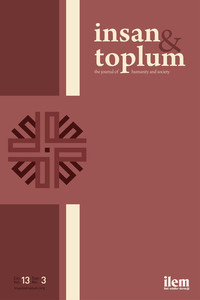The Road to the March 12 Memorandum and the Interim Regime’s Establishment: An Assessment in the Framework of Praetorianism Typology
Abstract
The March 12 Memorandum is the second military intervention disrupted democracy in Turkey during the multiparty period. The main reason of second intervention to democratic regime after 11 years is related with the opinion that regime shaped by soldiers did not work as they wishes. However, the intervention on March 12th differs from the coup in 1960 in terms of shape and the size of the intervention. While the soldiers took power directly on May 27, displacement coup took place on March 12th. In other words, the current Government was forced to resign and replaced with a new civilian government which acting under the direction of soldiers. One of the most important factors in determining the way of intervention on March 12th is the differences in political views among the politicized generals. Likewise, soldiers’ political perspective and the methods they chose accordingly were decisive on the political regime that took shape after the coup. At this point, the Praetorian typology put forward by Eric A. Nordlinger is very useful for understanding the political behavior of soldiers who have become political actors. Because Nordlinger’s conceptualization of moderate praetorianism makes it easier to understand the political perspectives of high-ranking officers and their political behavior during the march 12th process. To explain the March 12 Memorandum and the regime that was in effect between 1971 and 1973 in a theoretical framework and to understand the political process in this context will shed light on the path to September 12, when the soldiers directly seized the power - for the longest time.
References
- Hale, W. (1972). Aspects of the Turkish general election of 1969. Middle Eastern Studies, 8(3), ss. 393-404.
- Hale, W. (2014). Türkiye’de Ordu ve siyaset: 1789’dan günümüze. A. Fethi (Çev.), Alfa Yayınları.
- İnsel, A. (2007). Pretoryen devlet ve sahipleri. Birikim (Haziran 2007), ss. 17-21.
- İpekçi, A., ve Coşar, Ö. S. (2010). İhtilâlin İçyüzü. Türkiye İş Bankası Kültür Yayınları.
- Karataş, M. (2019). Türkiye’de asker- sivil ilişkileri bağlamında 12 Mart Muhtırası ve partiler üstü hükümet modeli üzerine bir değerlendirme. Anadolu ve Balkan Araştırmaları Dergisi 2(3), ss. 69-110.
12 Mart Muhtırası’na Giden Yol ve Ara Rejimin İhdası: Pretoryanizm Tipolojisi Çerçevesinde Bir Değerlendirme
Abstract
12 Mart Muhtırası çok partili dönemde Türkiye’de demokrasiyi kesintiye uğratan ikinci askeri müdahaledir. 27 Mayıs’ta yönetime el koyan askerlerin şekillendirdikleri rejimin arzu ettikleri ölçüde işlememesi, on bir yıl sonra askerlerin sivil yönetime tekrar müdahale etmesinin temel nedeni olmuştur. Ancak 12 Mart’ta gerçekleşen müdahale, şekil ve müdahalenin boyutu açısından 27 Mayıs 1960’ta gerçekleşen darbeden farklılıklar göstermektedir. Askerler, 27 Mayıs’ta iktidarı doğrudan ele alırken, 12 Mart 1971’de yerinden alma darbesi (displacement coup) geçekleşmiştir. Yani mevcut hükümet istifaya zorlanarak, yerine askerlerin güdümünde hareket eden yeni bir sivil hükümet kurulmuştur. 12 Mart’ta müdahale biçimimin belirlenmesinde en önemli faktörlerden biri ise politize olmuş üst düzey subayların arasındaki siyasete dair görüş ayrılıklarıdır. Keza askerlerin siyasete bakış açıları ve buna bağlı olarak seçtikleri yöntemler, darbe sonrasında şekillenen siyasal rejim üzerinde de belirleyici olmuştur. Bu noktada bir siyasi aktör haline gelen askerlerin siyaseten davranışlarını anlamak için Eric A. Nordlinger’in ortaya koyduğu Pretoryan tipoloji oldukça kullanışlıdır. Zira Nordlinger’in ılımlı pretoryanizm kavramlaştırması, 12 Mart sürecinde yüksek rütbeli subayların siyasete bakış açılarını ve buna bağlı olarak siyaseten davranışlarını anlamayı kolaylaştırmaktadır. 12 Mart Muhtırası’nı ve ardından 1971-1973 yılları arasında geçerli olan rejimi teorik çerçeveye oturtarak açıklamak ve siyasal süreci bu bağlamda anlamlandırmak askerlerin ülke yönetimini doğrudan -en uzun süre- ele aldıkları 12 Eylül’e giden yola ışık tutacaktır.
References
- Hale, W. (1972). Aspects of the Turkish general election of 1969. Middle Eastern Studies, 8(3), ss. 393-404.
- Hale, W. (2014). Türkiye’de Ordu ve siyaset: 1789’dan günümüze. A. Fethi (Çev.), Alfa Yayınları.
- İnsel, A. (2007). Pretoryen devlet ve sahipleri. Birikim (Haziran 2007), ss. 17-21.
- İpekçi, A., ve Coşar, Ö. S. (2010). İhtilâlin İçyüzü. Türkiye İş Bankası Kültür Yayınları.
- Karataş, M. (2019). Türkiye’de asker- sivil ilişkileri bağlamında 12 Mart Muhtırası ve partiler üstü hükümet modeli üzerine bir değerlendirme. Anadolu ve Balkan Araştırmaları Dergisi 2(3), ss. 69-110.
Details
| Primary Language | Turkish |
|---|---|
| Subjects | Political Science (Other) |
| Journal Section | Research Articles |
| Authors | |
| Publication Date | September 22, 2023 |
| Published in Issue | Year 2023 Volume: 13 Issue: 3 |


